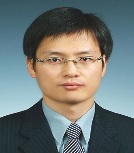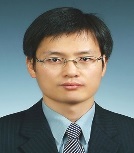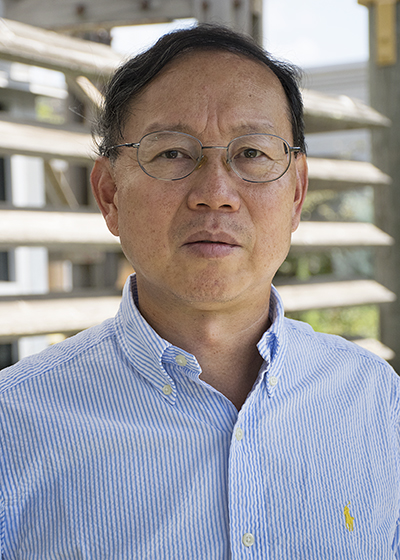Scientific Program
Keynote Session:
Title: Modeling of Phase Behaviors for Hydrogen Bonding Polymer Solution using PC-SAFT Equation of State
Biography:
Bong-Seop Lee has his expertise in modeling the phase behaviors on organic molecules, polymers, biological molecules (i.e., amino acid, peptide) and electrolyte solutions (i.e., inorganic salt, ionic liquids). In the master course, he suggested the Perturbed Hard-Sphere-Chain Association (PHSC-AS) equation of state which is combined the association term in SAFT to PHSC equation of state. In the Ph.D. course, he developed the electrolyte-PC-SAFT equation of state by combining PC-SAFT and primitive mean spherical approximation. During post-doc period, he focused on the modeling of physical and chemical properties of ionic liquid mixtures. In particular, he has been studied deeply about the dissociation and association of ionic liquids. Recently, he is interested in dissociation phenomena of weak and strong acids, and the equilibrium of various materials (polymer, blend, organic solvent) at the high-pressure condition.
Abstract:
Modeling of the phase behavior of polymer solutions is a crucial requirement to develop new polymer solution technologies and to design various polymer processes, such as purification, fractionation, devolatilization and polymer production. In particular, the liquid-liquid equilibrium (LLE) calculation is essential for processes design of polymerization.
The hydrogen bonding in polymer solutions leads to deviate remarkably from normal solutions behaviors and is a major causes of different phase behaviors. The perturbed-chain statistical association Fluid Theory (PC-SAFT) equation of state (EoS) is applied to calculate the pressure–volume–temperature (PVT), infinite dilution weight fraction activity coefficient (WFAC), vapor-liquid equilibrium (VLE) and liquid-liquid equilibrium (LLE) of associating polymer mixtures with hydrogen bonding association such as self- and cross-association with various phase behaviors such as upper critical solution temperature (UCST), the lower critical solution temperature (LCST) and closed-loop of polymer solutions. The PC-SAFT model shows a satisfactory performance.
Title: Thermogels as an injectable 3D scaffold
Biography:
Byeongmoon Jeong received his B.S. (1987) in the Department of Chemistry at Seoul National University, M.S (1989) from KAIST, and his Ph.D. (1999) in the Department of Pharmaceutics and Pharmaceutical Chemistry at the University of Utah. He worked at the Pacific Northwest National Laboratory, the USA as a senior research scientist before joining Ewha Woman's University in 2002. He pioneered biodegradable thermogels and has authored 120 international peer-reviewed papers and patents on stimuli-sensitive polymers; His publications have been cited 9,000 times during the last two decades. In 2009, he became Director of the National Research Laboratory on biodegradable thermogels. He received an Achievement Award in the Polymer Division of Korean Chemical Society (2010). He was selected as Ewha Fellow at Ewha Womans University in 2014. His research concentrates on stimuli-sensitive hydrogels and their applications for drug delivery and tissue engineering.
Abstract:
A PHP Error was encountered
Severity: 8192
Message: trim(): Passing null to parameter #1 ($string) of type string is deprecated
Filename: pastconference/past-program-schedule.php
Line Number: 239
Backtrace:
File: /efsdata/meetingsint-com/application/views/pastconference/past-program-schedule.php
Line: 239
Function: trim
File: /efsdata/meetingsint-com/application/controllers/Pastconference.php
Line: 128
Function: view
File: /efsdata/meetingsint-com/index.php
Line: 317
Function: require_once
Title: Solid-state characterization and stability tracking of drug-loaded micro- and nanofibrous delivery systems
Biography:
Romána Zelkó has her expertise in formulation and stability tracking of polymer-based drug delivery systems including various micro- and nanofibrous systems. Her research work focuses on different synthetic and natural polymeric delivery systems, physical ageing of polymers, microstructural characterization of dosage forms associated with their functionality-related characteristics. She is the author of 190 journal full papers and 5 patents and expert works. From 1991 she is employed by the Faculty of Pharmacy of the Semmelweis University. She advanced her studies in the pharmaceutical technology at the Ghent University, Belgium. She has been successfully passing the achievements of her scientific research work on to her students at various Ph.D. studies. She has held a variety of functions. She has served as a Vice-Dean (2003-2009) and from 2013 as the Dean of the Faculty of Pharmacy of the Semmelweis University.
Abstract:
The formulation of novel nanofiber-based drug delivery systems focusing on specific delivery purposes has been investigated worldwide. The favorable physico-chemical properties (high specific-area-to-volume ratio, high porosity and the possibility of controlling the crystalline-amorphous phase transitions of the loaded drugs), make them a desirable formulation pathway to satisfy the needs of modern pharmaceutical development. In regenerative medicine, a peculiar importance has been attributed to the structure of nanofibers because microarchitecture very similar to that of the extracellular matrix can be achieved. Fibrous delivery systems can facilitate drug release and increase solubility of small molecules. Moreover, they are capable for controlled drug delivery over time for local or systemic drug administration. The solubility of the polymer, the fiber diameter and the fiber structure are the primary parameters affecting drug release. In the case of small molecules, developments focus mostly on overcoming the unfavorable physicochemical feature of the active agents. However, the physical and chemical stability of these systems has not yet been thoroughly investigated and thus poses a challenge in their development.
The presentation intends to provide a comprehensive overview of non-invasive spectroscopic methods applied for the characterization of fibrous delivery systems, including a sensitive nuclear technique (Positron Annihilation Lifetime Spectroscopy), which enabled effective means for the detection and the prediction of possible supramolecular interactions based on the free volume changes initiated by stress conditions during storage. Since most of these interactions involve secondary bonds thus their rearrangements modify the size and distribution of free volume holes as a function of storage time. The applied experimental setup represents a useful approach to track the effect of ageing of the polymeric carrier on the solid-state changes of the active and the functionality-related characteristics of the delivery system.
A PHP Error was encountered
Severity: 8192
Message: trim(): Passing null to parameter #1 ($string) of type string is deprecated
Filename: pastconference/past-program-schedule.php
Line Number: 239
Backtrace:
File: /efsdata/meetingsint-com/application/views/pastconference/past-program-schedule.php
Line: 239
Function: trim
File: /efsdata/meetingsint-com/application/controllers/Pastconference.php
Line: 128
Function: view
File: /efsdata/meetingsint-com/index.php
Line: 317
Function: require_once
Title: HOT MELT EXTRUSION: AN EMERGING DRUG DELIVERY TECHNOLOGY
Biography:
Rashid Mahmood has Master Degree in Analytical Chemistry and MS in Total Quality Management. He has 13 years of experience of Pharmaceutical Quality Operations and has attended many international conferences as a keynote speaker. He has presented various talks in USA & China on Cleaning Validation, cGMP Guidelines and Quality Risk Management. Currently he is working as a Senior Executive Manager Quality Operations for Surge Lab.(Manufacturer of Microencapsulated APIs, Liquid & Dry Powder Parentrals) which is the best export oriented company in Pakistan.
Abstract:
Over the last three decades hottechnology in developing molecular dispersions of active pharmaceutical ingredients (APIs) into polymers matrices and has already been demonstrated to provide time controlled, modified, extended and targeted drug delivery resulting in improved opportunity for use of materials in order to mask application of the extrusion process back in the 1930’s HME has received considerable attention from both the pharmaceutical industry and academia in a range of applications for pharmaceutical dosage forms, such as tablets, capsules, films and implants for drug delivery through oral, transdermal and transmucosal routes. This makes HME an excellent alternative to other conventionally available techniques such as roll spinning and spray drying. In addition to being a proven manufacturing process, HME meets the goal of the US Food and Dru technology (PAT) scheme for designing, analyzing as well as controlling the manufacturing process through quality control measurements during active extrusion process.The use of hot-melt extrusion (HME) within the pharmaceutical industry is steadily increasing, due to its proven ability to efficiently manufacture pressure and agitation through and susequently forcing them out through a die. Twin development as it imparts both dispersive and distributive mixing. It blends materials while also imparting high shear to break-up particles and disperse them. HME extrusion has been shown to molecularly disperse poorly soluble drugs in a polymer carrier, increasing dissolution rates and bioavailability.
Oral Session 1:
- Biopolymers|Bioplastics|PolymersforDrugDelivery|PolymerChemistry
Title: Modeling of Phase Behaviors for Hydrogen Bonding Polymer Solution using PC-SAFT Equation of State
Biography:
Bong-Seop Lee has his expertise in modeling the phase behaviors on organic molecules, polymers, biological molecules (i.e., amino acid, peptide) and electrolyte solutions (i.e., inorganic salt, ionic liquids). In the master course, he suggested the Perturbed Hard-Sphere-Chain Association (PHSC-AS) equation of state which is combined the association term in SAFT to PHSC equation of state. In the Ph.D. course, he developed the electrolyte-PC-SAFT equation of state by combining PC-SAFT and primitive mean spherical approximation. During post-doc period, he focused on the modeling of physical and chemical properties of ionic liquid mixtures. In particular, he has been studied deeply about the dissociation and association of ionic liquids. Recently, he is interested in dissociation phenomena of weak and strong acids, and the equilibrium of various materials (polymer, blend, organic solvent) at the high-pressure condition.
Abstract:
Modeling of the phase behavior of polymer solutions is a crucial requirement to develop new polymer solution technologies and to design various polymer processes, such as purification, fractionation, devolatization and polymer production. In particular, the liquid-liquid equilibrium (LLE) calculation is essential for processes design of polymerization.
The hydrogen bonding in polymer solutions leads to deviate remarkably from normal solutions behaviors and is a major causes of different phase behaviors. The perturbed-chain statistical association Fluid Theory (PC-SAFT) equation of state (EoS) is applied to calculate the pressure–volume–temperature (PVT), infinite dilution weight fraction activity coefficient (WFAC), vapor-liquid equilibrium (VLE) and liquid-liquid equilibrium (LLE) of associating polymer mixtures with hydrogen bonding association such as self- and cross-association with various phase behaviors such as upper critical solution temperature (UCST), the lower critical solution temperature (LCST) and closed-loop of polymer solutions. The PC-SAFT model shows a satisfactory performance.
Title: Concentration Regimes of Biopolymers Xanthan, Tara and Clairana, Comparing Dynamic Light Scattering and Distribution of Relaxation Time
Biography:
Dra. Patrícia Diaz de Oliveira is an adjunct Professor at Biotechnology College and in Postgraduate Programs of Biotechnology and Food Science and Technology at Federal University of Pelotas, in Pelotas, Rio Grande do Sul, Brazil. She holds a degree in Chemical Engineering from the Federal University of Rio Grande (FURG) and a doctorate in Biotechnology from Federal University of Pelotas (UFPel), doing its research activities at the Biopolymers Laboratory of UFPel. Works specifically with the xanthan pruni hydrocolloid, synthesized by genuinely Brazilian strains of Xanthomonas arboricola pv pruni, and with which performs studies about production, characterization, and application since 2000. Also researches production, characterization, and biodegradation of the bioplastic polyhydroxy butyrate [P(3HB)],synthesizing by Brazilian isolates.
Abstract:
The aim of this work was to evaluate the utilization of analysis of the distribution of relaxation time (DRT) using a dynamic light back-scattering technique as alternative method for the determination of the concentration regimes in aqueous solutions of biopolymers (xanthan, clairana and tara gums) by an analysis of the overlap (c*) and aggregation (c**) concentrations. The diffusion coefficients were obtained over a range of concentrations for each biopolymer using two methods. The first method analysed the behaviour of the diffusion coefficient as a function of the concentration of the gum solution. This method is based on the analysis of the diffusion coefficient versus the concentration curve. Using the slope of the curves, it was possible to determine the c* and c** for xanthan and tara gum. However, it was not possible to determine the concentration regimes for clairana using this method. The second method was based on an analysis of the DRTs, which showed different numbers of relaxation modes. It was observed that the concentrations at which the number of modes changed corresponded to the c* and c**. Thus, the DRT technique provided an alternative method for the determination of the critical concentrations of biopolymers.
Title: Influence of surface charge density and NaCl concentration on the intrinsic viscosity of cellulose nanocrystal suspensions
Biography:
Dr. Siqun Wang is a Professor in the UT Center for Renewable Carbon. His research interests include Nano-mechanics, cellulose nano materials, bio-based carbon materials, manufacture and performance of wood-based composites, natural fiber-reinforced plastic composites, bio nanocomposites, wood adhesion, cellulose nano material impact on soil, soil recovery, heave metal removal from water, and wood quality. Dr. Wang has authored or co-authored more than 200 referred journal articles.
Abstract:
Cellulose nanocrystals (CNCs) with similar size and various surface charge densities were prepared by sulfuric acid hydrolysis and NaOH desulfation. The influence of surface charge density and NaCl concentration on the intrinsic viscosity of CNC suspensions and predicted aspect ratio were investigated by Ubbelohde viscometer. With decreased CNC surface charge density, the intrinsic viscosity initially decreased due to the electric double layers on the CNC surface and subsequently increased due to CNC aggregation. To screen electroviscous effect, NaCl was added into CNC suspensions. With increased NaCl concentration, the intrinsic viscosity of CNC suspensions first decreased and then increased. The aspect ratios of CNCs predicted by Batchelor equation from the minimum intrinsic viscosity were consistent with that measured by transmission electron microscopy (TEM). Suspensions of CNCs with higher surface charge density needed less NaCl to obtain minimum intrinsic viscosity. The NaCl content that should be added to the suspension to predict the actual physical aspect ratio of CNC can be estimated by Debye-Hückel theory, assuming that the Debye length is equal to the CNC diameter..
Title: Cationic Porphyrin Induced B-Z Transition of AT-Rich DNA
Biography:
Yun Jung Jang has her expertise in ligand-DNA interaction and synthesis of metal complexes that interact with DNA. Her main methodology to investigate drug-DNA interaction are polarized spectroscopies and various fluorescence techniques. She obtained her Ph. D. degree at Daedu Catholic University and worked for years in Yeungnam University as research assistant professor in the DNA-drug interaction field. She became assistant professor in the College of Basic Education, Yeungnam University.
Abstract:
Cationic porphyrins interact with DNAs. Binding mode of porphyrins depends on various factors including nature of DNA sequences and the periphery substituents. Trans-bis(N-methylpyridium-4-yl) diphenyl porphyrin (trans-BMPyP) also bind to DNAs. Upon binding to poly[d(A-T)2], typical circular dichroism (CD) spectrum in the DNA absorption region for B-form was reversed, suggesting formation of left-handed helical structure (Z-form). The formation of Z-form was confirmed by 31P NMR, in which a single 31P peak of B-form was split into two peaks, reflecting two distinctive environment for the DNA phosphate groups, which is typical for Z-form DNA. Trans-BMPyP-induce B-Z transition occurred specifically for polynucleotide having alternated AT sequences. No other combination of nucleobase sequence produced similar B-Z transition. This observation is in contrast with typical DNA sequence, alternating GC sequence (poly[d(G-C)2]), that exhibits the B-Z transition. Cationic porphyrin has been known to intercalate between GC base pairs, while they stack along AT-rich DNAs. Pattern of stacking along DNA stem may be an important factor for this alternating AT sequence-specific B-Z transition. B-Z transition of alternating AT sequence requires at least 14 base-pairs, supporting the importance of porphyrin stacking along AT stem. The position of cationic ion on the periphery methyl pyridine ion also takes an essential role. When the methyl group locates at meta- or para-position, both cationic porphyrins similarly induce B-Z transition, while that at ortho-position, in which free-rotation of pyridine ring is sterically prevented, did not. This observation also indicated the importance of stacking of porphyrins along poly[d(A-T)2] stem, because the former two porphyrins can be planar, therefore can stack each other. On the other hand, ortho-trans-BMPyP cannot be planar and stacking is inefficient.
Title: Effects of Rice Straw-Based Polyol on the Thermophysical Properties of Rigid Polyurethane Foam
Biography:
Kriztine Magadan-Icalina is a licensed chemical engineer and is currently taking up Master of Science in Material Science and Engineering in Mindanao State University-Iligan Institute of Technology. Her master’s thesis is focused on the formulation and characterization of a water-blown rigid polyurethane foams from a lignocellulosic rice straw-based polyol. Her passion is on research and teaching.
Abstract:
Statement of the Problem: Vegetable oils and lignocellulosic biomass are two major types of bio-based resources gaining interest for bio-based polyols for polyurethane (PU) production. However, the consumption of huge amounts of vegetable oils could result in a shortage of vegetable oils and will cause the increase in food prices. Therefore, lignocellulosic biomass is seen as a better alternative raw material for PU production. Various kinds of lignocellulosic biomass, have been used for the production of bio-based PU foams but the use of lignocellulosic rice straw is not yet explored. Thus, the study aims to develop a PU rigid foam from rice straw-based polyol and investigate the effect of isocyanate index on the thermophysical properties of the foam. Methodology & Theoretical Orientation: PU foams were prepared by reacting isocyanates in varying indices with polyols containing 15% of rice straw-based polyol and 85% petroleum-based polyol and their thermal conductivity, density and compressive strength were determined. Findings: PU foams with no biopolyol replacement has superior thermal and mechanical properties over the PU foams with biopolyol replacement. However, those with biopolyol replacement were significant less dense compared to the commercial formulation. This could indicate possible application in industries where lightweight materials is important. Thermal characterization of the foam samples at different isocyanate indices indicate that increasing the isocyanate content improves insulation property of the PU as evident with the decreasing conductivity. This is also true with compressive strength. The index is directly proportional to the compressive strength. Density, on the other hand, is directly proportional to the isocyanate content. Conclusion & Significance: Successful development of PU rigid foam products using biomass-based polyols obtained from a renewable feed stock rice straw offers a practical and economic procedure for potential scale-up and commercialization.
A PHP Error was encountered
Severity: 8192
Message: trim(): Passing null to parameter #1 ($string) of type string is deprecated
Filename: pastconference/past-program-schedule.php
Line Number: 354
Backtrace:
File: /efsdata/meetingsint-com/application/views/pastconference/past-program-schedule.php
Line: 354
Function: trim
File: /efsdata/meetingsint-com/application/controllers/Pastconference.php
Line: 128
Function: view
File: /efsdata/meetingsint-com/index.php
Line: 317
Function: require_once

Rosal Jane G. Ruda
Mindanao State University – Iligan Institute of Technology Iligan City, PhilippinesTitle: Response Surface Method Optimization of Rice Straw-Liquefaction using Crude Glycerol for Rigid Polyurethane Foam Application
Biography:
Rosal Jane G. Ruda is a licensed chemical engineer, currently taking up Master of Science in Materials Science and Engineering at Mindanao State University – Iligan Institute of Technology. She is also currently working as a University Research Associate under Dr. Arnold A. Lubguban working in polymer research. She graduated with honors in her undergraduate program. She was also given recognition for graduating under the RA 2687 Scholarship Program under the Department of Science of Technology.
Abstract:
Statement of the Problem: Polyurethane is a versatile class of polymer produced from the condensation polymerization of isocyanates and polyol, a hydroxyl-rich compound. Its application can be found in adhesives, sealants, coatings, flexible and rigid foams. However, polyol is traditionally sourced from petroleum raw materials. With increasing environmental and sustainability problems, lignocellulosic biomass is a potential alternative source due to its abundance, biodegradability and its hydroxyl component. In the Philippines, 11.3 M tons of rice straw is produced annually which when burned, produces air pollutants such as carbon dioxide, nitrogen oxide and sulfur dioxide. Rice straw can be liquefied using an atmospheric liquefaction process with the use of a catalyst. Researchers reported that varying liquefaction parameters can significantly alter the properties of a polyol3. The purpose of the study is to produce rice straw-based polyol with a low acid number, high OH number, low viscosity and high liquefaction ratio which is suitable for rigid foam applications. Methodology & Theoretical Orientation: A one-pot liquefaction process was used to liquefy rice straw with the use of sulfuric acid as catalyst and crude glycerol as liquefaction solvent. Response surface methodology was used to optimize four factors: acid loading, biomass loading, reaction time and reaction temperature based on four responses: acid number, OH number, liquefaction ratio, and viscosity. Findings: Statistical analysis showed that all four factors have a significant effect on polyol properties. Increasing the acid loading was shown to significantly increase residual acid while higher reaction times lead to a decrease in liquefaction efficiency. Polyols with optimum properties were produced at a reaction time of 180-300 minutes, acid loading of 1-2%, reaction temperature of 170-180°C, and a biomass loading of 10-15%.
A PHP Error was encountered
Severity: 8192
Message: trim(): Passing null to parameter #1 ($string) of type string is deprecated
Filename: pastconference/past-program-schedule.php
Line Number: 354
Backtrace:
File: /efsdata/meetingsint-com/application/views/pastconference/past-program-schedule.php
Line: 354
Function: trim
File: /efsdata/meetingsint-com/application/controllers/Pastconference.php
Line: 128
Function: view
File: /efsdata/meetingsint-com/index.php
Line: 317
Function: require_once
Title: Preparation Of Intelligence Antibacterial Films Based On Low Density Poly Ethylene And Evaluation Of Its Properties
Biography:
Pouria Atabaki Pasdar was born in Orumiyeh, Iran, in 1989. He received the bachelor degree in Polymer engineering from the Islamic Azad University, Science and Research branch, Tehran, Iran, in 2013, and he is studying the master of Polymer engineering in the same university since 2015. His current research is investigation on food packaging and bioplastics and nanotechnology in order to increasing the shelflife of food packages. Besides, he had cooperated with polymer and petrochemical institute since 2016 in terms of producing Antibacterial and Nano films packaging. Moreover, he had invent a chemical car which are participated in chemicar competition in 2012.
Abstract:
In this article, antibacterial film based on low density polyethylene (LDPE), potassium sorbate (KS) and ethylene vinyl alcohol (EVOH) copolymer were prepared and characterized using scanning electron microscopy(SEM), transmission electron microscopy (TEM), X-ray diffraction (XRD), differential scanning calorimetry (DSC), and tensile tests. The oxygen barrier properties of the LDPE/EVOH/KS film were significantly better than those of the LDPE/KS film. In addition to barrier properties, the LDPE/EVOH/KS film also had better elastic modulus than their counterparts without EVOH. The antimicrobial film containing potassium sorbate decreased the growth rate and maximum growth of yeast, and extended the lag period before mold growth was apparent. Therefore, it can prevent or reduce the rate of microbial spoilage in low viscosity liquids and on the contacted surface area of solid food products and as the result may prolong the shelf life of food products when it is used as a packaging material. Also, a novel sticker sensor has been fabricated based on methyl red, and tests have been conducted to detect the freshness of meat by its color change in real time (when the red methyl red paper changed to yellow). These are prepared by entrapping within a pH sensitive dye that responds, through visible color changes to the spoilage volatile compounds that contribute to a quantity known as total volatile basic nitrogen (TVBN). Finally, the methyl red was successfully used as a sticker sensor for the real-time monitoring of meat freshness in ambient and chiller conditions.
A PHP Error was encountered
Severity: 8192
Message: trim(): Passing null to parameter #1 ($string) of type string is deprecated
Filename: pastconference/past-program-schedule.php
Line Number: 354
Backtrace:
File: /efsdata/meetingsint-com/application/views/pastconference/past-program-schedule.php
Line: 354
Function: trim
File: /efsdata/meetingsint-com/application/controllers/Pastconference.php
Line: 128
Function: view
File: /efsdata/meetingsint-com/index.php
Line: 317
Function: require_once
Title: Preparation Of Intelligence Barrier Films Based On Low Density Poly Ethylene And Evaluation Of Its Properties
Biography:
Babak Bahari Aban was born in Tehran, Iran, in 1990. He received the bachelor degree in Polymer engineering from the Islamic Azad University, Science and Research branch, Tehran, Iran, in 2013, and he is studying the master of Polymer engineering in the same university since 2015. His current research is investigation on food packaging and bioplastics and nanotechnology in order to increasing the shelflife of food packages. Besides, he had cooperated with polymer and petrochemical institute since 2016 in terms of producing Antibacterial and Nano films packaging. Moreover, his bi-cultural background and focus on community collaboration has led him to a number of volunteer opportunities and community leadership roles.
Abstract:
In this article, nanocomposite films based on low density polyethylene (LDPE), organoclay (OC) and ethylene vinyl alcohol (EVOH) copolymer were prepared and characterized through using scanning electron microscopy(SEM), transmission electron microscopy (TEM), X-ray diffraction (XRD), differential scanning calorimetry (DSC), oxygen permeation measurements, and tensile tests. The oxygen barrier properties of the LDPE/EVOH/OC film were better than those of the LDPE/OC film. In addition to barrier properties. Furthermore, from the TEM micrographs, the O2 permeability through the films was evaluated, which illustrated that adding both OC and LDPE to EVOH leads to a remarkable increase in the barrier properties of EVOH films. Also, a new colorimetric indicator sensor based on methyl red was sensitive to total volatile basic nitrogen (TVBN) released from red meat during storage which has been fabricated for real-time monitoring of meat quality. The methyl red as a freshness sensor worked based on pH increase as the basic spoilage volatile amines produced gradually in the package headspace, and subsequently, the colour of the sensor will change for spoilage indication, which is easily visible to the naked eye. The results reveal that the sticker sensor could be used to determine the degree of red meat cut freshness, as the relationship between the colour change of methyl red as a sensor response and the meat freshness follows a similar trend. Results have indicated that sensor response correlated well with microbial load of red meat, thus enabling the sensor for real-time monitoring of red meat spoils.
Keynote Session:
Oral Session 1:
- Polymers for Drug Delivery| Polymeric Biomaterials| Biopolymers Applications| Biopolymers for Tissue Engineering| Polymer Nanotechnology| Nanotechnology in Drug Delivery
Title: Self-assembled Tripeptide Fibers as Prebiotic RNA Binders
Biography:
Tony Z. Jia is a part of the Earth-Life Science Institute at the Tokyo Institute of Technology in Tokyo, Japan. There, we are interested in studying the origin and evolution of the Earth, of life on Earth, as well as life on other planets. As a part of this institute, Tony’s research interests include prebiotic and ancient biopolymer formation and evolution. Specifically, one of the most interesting topics in prebiotic chemistry involves supramolecular self-assembly of short peptide and nucleic acid polymers; these self-assemblies could possibly have facilitated the initial emergence of life on Earth.
Abstract:
Before the emergence of the first RNA polymerase ribozyme, sustained nonenzymatic replication of RNA was crucial to the development of early life. To that end, cationic peptides have been hypothesized to be able to assist in template-directed nonenzymatic RNA polymerization by binding to and selectively inhibiting the annealing of long, complementary RNA strands; these strands can then act as templates for free primer strands, resulting in progressive replicative turnovers. However, the geochemical scenarios that would allow for the accumulation of high concentrations of long, cationic peptide oligomers are not likely. Recently, it has been discovered that certain tripeptide systems can spontaneously self-assemble into hydrogels and fibrillar macrostructures. As the accumulation of high concentrations of peptide trimers is much more likely than longer oligopeptides on the early earth, we probed the self-assembly properties and RNA-binding affinities of six tripeptides, each containing a cationic residue in the N-terminal position followed by an aromatic or hydrophobic dyad. KYF and RFF showed the best fibrillar self-assembly propensity—RFF is the first purely-peptidic arginine-containing tripeptide to self-assemble—and microscopy and binding assays show that RNA indeed binds to the structures generated by these tripeptides. In fact, binding of a fluorescent RNA to cationic fibrillar macrostructures resulted in a direct label-free method of visualizing the kinetics of nanostructure assembly in real time. As these tripeptide assemblies are also reasonably heat-stable and do not prohibitively inhibit nonenzymatic RNA replication, our studies suggest that cationic tripeptide nanostructures could have been prebiotically-plausible RNA-binders, potentially possessing the ability to assist in the replication and eventual evolution of early genetic systems.
A PHP Error was encountered
Severity: 8192
Message: trim(): Passing null to parameter #1 ($string) of type string is deprecated
Filename: pastconference/past-program-schedule.php
Line Number: 354
Backtrace:
File: /efsdata/meetingsint-com/application/views/pastconference/past-program-schedule.php
Line: 354
Function: trim
File: /efsdata/meetingsint-com/application/controllers/Pastconference.php
Line: 128
Function: view
File: /efsdata/meetingsint-com/index.php
Line: 317
Function: require_once

Achyut Konwar
Physical Sciences Division, Institute of Advanced Study in Science and Technology, India.Title: CHITOSAN HYDROGEL BASED NANO-COMPOSITE SYSTEM WITH SELF-HEALING ABILITY: FILMS AND PATCHES
Biography:
Achyut Konwar has been working with fabrication of different types bio-polymeric hybrid materials. He has also experience of working with thermoplastic polymers, FRP as well as polymer nanocomposites. He is passionate about development of novel hybrid materials which can find practical application in different fields like medical, packaging, industry as well as house hold etc. He is also inspired to develop polymeric products from low cost raw materials, waste products with eco-compatibility, sustainability and biodegradability.
Abstract:
Introduction: Bio-polymeric hydrogel system prepared from chitosan cross-linked with glycerol possesses the self-healing ability, which enables this fantastic hydrogel material to form smooth films or coating. By successful utilization of this self-healing ability possessed by this hydrogel material we have fabricated different types of nano-composite hybrid biomaterials.
Methods: In the first approach chitosan nano-composite hydrogel was fabricated by using Carbon dots (CDs) synthesized from commercially available Assam CTC tea. Then a composite nanomaterial was also synthesized by coating the surface of graphene oxide by the iron oxide nanoparticle and this composite nanomaterial was used to fabricate chitosan-iron oxide coated graphene oxide nanocomposite hydrogel films. This chitosan based hydrogel system was also used to fabricate a kind of super absorbent patch using cotton wool. We also modified the patch by incorporating graphene oxide (GO) into this hydrogel system. The films and the patches were fabricated by gel casting technique and by the compression moulding technique respectively.
Results and Discussions: The films obtained from chitosan-CDs nano-composite hydrogel system showed UV-blocking ability along with the improved mechanical and thermal property. Chitosan-iron oxide coated graphene oxide nanocomposite hydrogel films are robust along with another interesting property; the antimicrobial activity. Cotton based patches after loading GO showed antimicrobial activity ae well as efficient wound healing ability when tested in animal model and thus can serve as a bandage material. The main advantage of such patches is that any type of chemicals, drugs, nano or micro particles can be loaded in it as per requirement. Since chitosan is a bio-polymer having the inherent property of biodegradability and biocompatibility, so such type of films and patches fabricated from chitosan based hydrogel system may find high potential application in the bio-medical as well as food packaging industry. The patches may have application in the textile industry as well.
A PHP Error was encountered
Severity: 8192
Message: trim(): Passing null to parameter #1 ($string) of type string is deprecated
Filename: pastconference/past-program-schedule.php
Line Number: 354
Backtrace:
File: /efsdata/meetingsint-com/application/views/pastconference/past-program-schedule.php
Line: 354
Function: trim
File: /efsdata/meetingsint-com/application/controllers/Pastconference.php
Line: 128
Function: view
File: /efsdata/meetingsint-com/index.php
Line: 317
Function: require_once
Title: Synthesis of Polyurethane Coating Using Castor Oil As A Bio-polyol and Its
Biography:
Abstract:
India is the world largest producer of castor oil. Castor oil is a non-edible oil. Castor oil can be utilized for manufacturing polyurethane due to its inherent structural beauty in terms of presence of OH groups in its structure along with the functionality of 2.7. Hence an attempt has been made by utilizing castor oil as a renewable source of polyol for manufacturing PU coating. In the present work PU coating was prepared by varying the stoichiometric ratio of castor oil and toluene diisocyanate (TDI). The reaction was carried out without catalyst and by using DBTL catalyst separately. The prepared coating samples were characterized for mechanical properties like hardness, scratch resistance, pot life and chemical resistance.
A PHP Error was encountered
Severity: 8192
Message: trim(): Passing null to parameter #1 ($string) of type string is deprecated
Filename: pastconference/past-program-schedule.php
Line Number: 354
Backtrace:
File: /efsdata/meetingsint-com/application/views/pastconference/past-program-schedule.php
Line: 354
Function: trim
File: /efsdata/meetingsint-com/application/controllers/Pastconference.php
Line: 128
Function: view
File: /efsdata/meetingsint-com/index.php
Line: 317
Function: require_once
Title: Thermogels as an injectable 3D scaffold
Biography:
Byeongmoon Jeong received his B.S. (1987) in the Department of Chemistry from Seoul National University, M.S (1989) from KAIST, and his Ph.D. (1999) in the Department of Pharmaceutics and Pharmaceutical Chemistry at the University of Utah. He worked at the Pacific Northwest National Laboratory, USA as a senior research scientist before joining Ewha Womans University in 2002. He pioneered biodegradable thermogels and has authored 120 international peer-reviewed papers and patents on stimuli-sensitive polymers; His publications have been cited 9,000 times during the last two decades. In 2009, he became Director of the National Research Laboratory on biodegradable thermogels. He received an Achievement Award in the Polymer Division of Korean Chemical Society (2010). He was selected as Ewha Fellow at Ewha Womans University in 2014. His research concentrates on stimuli-sensitive hydrogels and their applications for drug delivery and tissue engineering.















